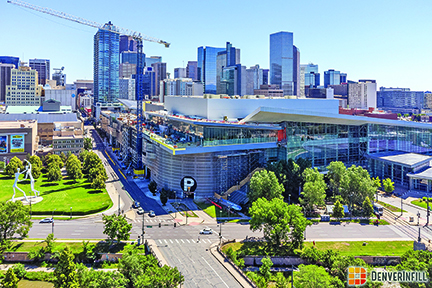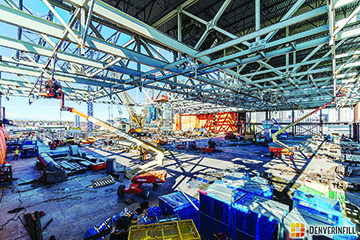by Glen Richardson

Finish Line Finale: The $233 million Colorado Convention Center expansion is projected to finish by year end. Project will add an additional 200,000-sq.-ft. of space to be maintained.
As the $233 million Colorado Convention Center expansion nears completion, the agency responsible for the facility warns that the current 2.2 million-sq.-ft. structure is in horrendous shape and in danger of becoming a catastrophe.
Furthermore, despite an increase in convention center meeting volume this year (2023), of the more than 180 conventions booked in the U.S. by mid-Sept. for 2024, the only one reserved at the Convention Center by that date was the July 4-7 Fan Expo.
The city is more than $62 million behind in deferred maintenance costs, and Denver Arts & Venues guestimates that the amount has ballooned above $70 million.
Trash & Turnover
The crux and reality are that the sources of funds for capital improvement are not keeping up with what’s needed for a building of this magnitude, was how Denver Arts & Venues Executive Director Ginger White explained it.
Fantasizing to solve the problem, new Denver Mayor Mike Johnston ended her 18-year career by firing her at the end of September. He has not named a replacement or put a deputy in charge of the 100-employee department. Deputy Molly Wink has subsequently taken a job at DIA, increasing the convention center crisis.
Arts & Venues also manages Red Rocks, DCPA, the McNichols Bldg., and the Ellie Caulkins Opera House, potentially placing those venues into a crisis comparable to that of the Convention Center. Combined, those venues generate $90 million in annual revenue and attract three million people yearly.
Swept Under Carpet

Seedy Sight: Colorado Convention Center’s Big Blue Bear looks in on rundown, dirty conditions in current space. City lacks funds for maintenance of building’s huge space.
Led by the new mayor, the city has tried to keep the Convention Center crisis a clandestine hush-hush secret. Arts & Venues’ Ginger White did not leak the convention complex maintenance problem; the information was obtained through an open records request by NPR’s online news site Denverite.
Ending homelessness — seemingly the mayor’s only priority — is a factor in the decline of city conventions. So is reducing crime downtown and finishing the 16th Street Mall and Larimer Square. Safety remains downtown’s chief flashpoint. Large city hotels say potential tourists, travelers, and business guests continue to say safety is a top priority when choosing whether to stay downtown.
The city’s Convention Center marketing has also slipped. Travel publications play an important role in tourism and conventions. Aurora and Colorado Springs still market in trade publications such as Meetings Today. Denver has done nothing in 2023. Furthermore, online convention material doesn’t appear to have been updated in months.
Maintenance Mess

Crowd Collapse: In 2016 the Convention Center recorded 967,543 attendees, the most ever. Six years later in 2022, the center’s 140 conventions drew a meager 547,526 attendees.
Denver spends among the least in the nation for convention center maintenance among similar sized sites. Using 2019 as a comparison to other convention centers, Denver’s operating gap — revenue less expenses — is the lowest in its competitive set.
For a decade, Denver allocated just $1 million a year for maintenance. In 2023, the city raised the figure to $5 million, albeit the new mayor may not approve the funds. Fixing escalators doesn’t have political sex appeal.
Nevertheless, the Convention Center is a crucial component for maintaining Denver’s financial well-being. If the Convention Center isn’t functioning, it reduces the amount of money the city can spend on daily operations and addressing residential issues.
Expansion Elements
Expected to be completed by the end of this year and open in 2024, the massive Colorado Convention expansion project will add an additional 200,000-sq.-ft. of space. The expansion will bring the facility to 2.4 million sq.-ft. It includes a 30,000-sq.-ft. back-of-the-house area, an 80,000-sq.-ft. ballroom, a 20,000-sq.-ft. terrace, and new pre-function areas.
When complete the ballroom will be the largest in Colorado. The space can be divided into 19 configurations. Leading out of the ballroom is a 20,000-sq.-ft. terrace with views of downtown and the mountains.
The southwest portion of the existing Convention Center, closest to Speer Blvd., featured an 80-ft. ceiling and glass curtain wall. As part of the expansion, a second level is going in, which will be used as pre-function space. It requires attaching the new floor to the existing structure and will include a set of long escalators.
Seesaw Saga

Classy Curtain Wall: Expansion along the southwest portion of the existing Convention Center — closest to Speer Blvd. —will have an 80-ft. ceiling and glass curtain wall.
The largest number of events in Denver was 246 back in 2010. Six years later in 2016 the Convention Center recorded the most attendees at 967,543. In 2022 the number had dropped to 140 conventions with 547,526 attendees.
The city’s image has been a factor in the decline in number of conventions and attendees. U.S. News & World Report rated Denver as the second-best place to live in 2020. In 2023 the city had dropped from second place to 99th.
Owned by the City & County of Denver, the Convention Center has been privately managed by ASM Global since 1994. Expecting a post-pandemic uptick, the City Council approved a new 10-year, $250 million contract for ASM Global, commencing Jan. 1, 2024.
Turbulence Threat

Big Ballroom: DenverInfill photo shows construction underway at the Convention Center’s 80,000-sq.-ft. ballroom. When completed it will be the biggest in Colorado.
A decade of limited maintenance by the city at the original convention center structure has turned a dust devil into a violent whirlwind, creating turbulence and instability as the new $233 million expansion nears completion. Moreover, the rotating updraft is a foreboding threat to downtown Denver’s comeback.
Trying to sweep the crisis under the carpet, the new mayor’s firing of Arts & Venues Executive Director Ginger White — followed by the quick exit of Deputy Director Molly Wink — has created a supercell. The sudden change in direction without warning now threatens the Denver Center for Performing Art and Red Rocks Amphitheatre, as the crisis swirls into a severe storm.
Amid the small whirls of dust, the landlord for the city’s Convention & Visitors Bureau is converting the space into residential units, forcing Visit Denver to move for the first time in 30 years. Richard W. Scharf Jr. — Visit Denver CEO and now the city’s only veteran convention person — may be caught in the atmosphere of chaos and also fired, turning the Convention Center crisis into a cyclone.
